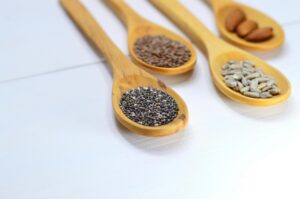In recent years, high protein foods have gained immense popularity among health enthusiasts, athletes, and anyone looking to maintain a balanced diet. This guide will explore what high protein foods are, their benefits, and various sources of protein, along with tips for incorporating them into your meals. By understanding the role of protein in our diets and the foods that provide it, you can make more informed choices about your nutrition.
What Are High Protein Foods?
High protein foods are those that contain a significant amount of protein relative to their total calorie content. Protein is an essential macronutrient, vital for building and repairing tissues, producing enzymes and hormones, and supporting overall bodily functions. Foods high in protein can be found in both animal and plant sources.
Understanding Protein
Before diving into specific foods, it’s essential to understand what protein is and why it’s crucial for our health. Proteins are made up of smaller units called amino acids, which are necessary for numerous bodily functions. There are 20 different amino acids, nine of which are considered essential, meaning they must be obtained from our diet since our bodies cannot produce them.
Daily Protein Requirements
The recommended daily allowance (RDA) for protein varies by age, sex, and activity level. Generally, adults should aim for about 46 grams per day for women and 56 grams per day for men. However, athletes or those with higher activity levels may require more to support muscle repair and growth. A common guideline is to consume around 0.8 grams of protein per kilogram of body weight.
Benefits of High Protein Foods
Incorporating high protein foods into your diet offers numerous health benefits. Here are some key advantages:
1. Supports Muscle Growth and Repair
Protein plays a critical role in muscle growth and repair. Consuming sufficient protein, especially after exercise, helps repair muscle fibers and promotes muscle growth. This is particularly important for athletes or those engaged in regular physical activity.
2. Aids Weight Management
High protein foods can promote satiety, which helps control hunger and reduce overall calorie intake. Including more protein in your meals may lead to better weight management, making it easier to maintain a healthy weight.
3. Boosts Metabolism
Eating protein-rich foods can increase your metabolic rate, as the body burns more calories digesting protein compared to fats or carbohydrates. This thermic effect of food can support weight loss or maintenance efforts.
4. Enhances Bone Health
Research suggests that adequate protein intake supports bone health by increasing bone density and reducing the risk of osteoporosis. This is especially important as we age.
5. Supports Immune Function
Protein is vital for producing antibodies and immune cells, which help fight infections and diseases. A diet rich in protein can help maintain a healthy immune system.
Sources of High Protein Foods
High protein foods come from various sources, including animal products and plant-based options. Here’s a detailed look at some of the best sources of protein:
Animal-Based High Protein Foods
1. Meat
- Chicken Breast: A lean source of protein, chicken breast contains about 31 grams of protein per 100 grams. It’s versatile and can be used in various dishes.
- Turkey: Similar to chicken, turkey is another lean meat option, providing around 29 grams of protein per 100 grams.
- Beef: Lean cuts of beef, such as sirloin, can contain up to 26 grams of protein per 100 grams. Beef is also a great source of iron and vitamin B12.
- Pork: Lean pork, such as tenderloin, provides about 27 grams of protein per 100 grams. It’s flavorful and can be prepared in many ways.
2. Fish and Seafood
- Salmon: Rich in omega-3 fatty acids, salmon contains about 25 grams of protein per 100 grams. It’s great for heart health and can be grilled, baked, or smoked.
- Tuna: Tuna is a highly concentrated source of protein, offering approximately 30 grams per 100 grams. Canned tuna is a convenient option for salads and sandwiches.
- Shrimp: Low in calories and high in protein, shrimp contains about 24 grams per 100 grams. It’s quick to cook and can be added to stir-fries or pasta dishes.
3. Dairy Products
- Greek Yogurt: Packed with protein, Greek yogurt contains about 10 grams per 100 grams. It’s also a good source of probiotics for gut health.
- Cottage Cheese: Cottage cheese provides around 11 grams of protein per 100 grams. It’s versatile and can be used in savory or sweet dishes.
- Cheese: Hard cheeses like Parmesan and Cheddar can contain between 25 to 30 grams of protein per 100 grams, making them a tasty and protein-rich addition to meals.
Plant-Based High Protein Foods
1. Legumes
- Lentils: Lentils are a fantastic plant-based protein source, providing about 9 grams of protein per 100 grams. They are rich in fiber and can be used in soups, stews, and salads.
- Chickpeas: Chickpeas contain around 19 grams of protein per 100 grams. They’re great for making hummus or adding to salads and curries.
- Black Beans: With about 21 grams of protein per 100 grams, black beans are a versatile ingredient that can be used in tacos, salads, and soups.
2. Nuts and Seeds
- Almonds: Almonds contain approximately 21 grams of protein per 100 grams. They’re great as a snack or can be added to oatmeal and salads.
- Chia Seeds: Chia seeds offer about 17 grams of protein per 100 grams. They are also high in omega-3 fatty acids and can be added to smoothies or yogurt.
- Pumpkin Seeds: Pumpkin seeds contain around 30 grams of protein per 100 grams. They make a nutritious snack or topping for salads.
3. Whole Grains
- Quinoa: Quinoa is a complete protein, providing about 14 grams of protein per 100 grams. It’s gluten-free and can be used as a base for salads or bowls.
- Oats: Oats offer about 13 grams of protein per 100 grams. They make a nutritious breakfast option and can be added to smoothies or baked goods.
- Brown Rice: Brown rice contains around 2.5 grams of protein per 100 grams, which may seem low, but it’s a staple carbohydrate source that can complement protein-rich dishes.
Tips for Incorporating High Protein Foods into Your Diet
Now that you know the various sources of high protein foods, here are some practical tips for incorporating them into your daily meals:
1. Start Your Day with Protein
Incorporate high protein foods into your breakfast to help keep you full throughout the morning. Consider options like Greek yogurt with fruits and nuts, scrambled eggs with spinach, or protein-packed smoothies.
2. Snack Wisely
Choose high protein snacks to curb your hunger between meals. Snack on nuts, seeds, cheese, or hummus with vegetables for a satisfying and nutritious option.
3. Plan Protein-Rich Lunches
Include protein sources in your lunch to keep your energy levels stable. Add grilled chicken or tofu to salads, or choose sandwiches made with lean meats and whole grain bread.
4. Make Dinner Protein-Centric
Focus on making your dinner a protein-rich meal. Grilled fish, roasted chicken, or plant-based protein sources like lentil stew can provide a satisfying end to your day.
5. Experiment with Plant-Based Proteins
If you’re looking to reduce your meat consumption, try incorporating more plant-based protein sources into your meals. Experiment with lentils, chickpeas, and quinoa to create delicious and nutritious dishes.
6. Use Protein Supplements When Necessary
If you struggle to meet your protein needs through whole foods alone, consider using protein supplements like whey protein or plant-based protein powders. These can easily be added to smoothies or meals for an extra protein boost.
High Protein Foods for Specific Dietary Needs
Different individuals may have unique dietary needs and preferences. Here’s a closer look at high protein foods suitable for various diets:
1. Vegetarian and Vegan Diets
Vegetarians and vegans can find ample protein in legumes, nuts, seeds, tofu, tempeh, and whole grains. Foods like quinoa, lentils, and chickpeas are excellent sources of protein and can be creatively incorporated into meals.
2. Keto Diet
The ketogenic diet is high in fat and low in carbohydrates. For those following this diet, high protein foods include meats, fish, eggs, cheese, and low-carb vegetables like spinach and broccoli.
3. Gluten-Free Diet
Gluten-free options for high protein foods include meats, fish, eggs, dairy, legumes, and gluten-free grains like quinoa and brown rice. Always check labels to ensure processed foods are gluten-free.
4. Paleo Diet
The paleo diet focuses on whole foods, excluding processed foods, grains, and dairy. High protein foods in this diet include lean meats, fish, eggs, nuts, and seeds.
The Bottom Line
Incorporating high protein foods into your diet can have numerous health benefits, from supporting muscle growth to aiding in weight management. With a variety of sources available, including both animal and plant-based options, you can easily find high protein foods that suit your taste and dietary preferences.
By understanding the importance of protein and how to include it in your meals, you can make informed choices that support your overall health and well-being. Whether you’re an athlete, a busy professional, or someone looking to improve their diet, high protein foods are an excellent addition to any nutrition plan.













